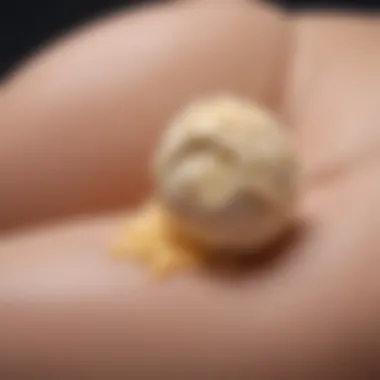Top Creams for Effective Pubic Hair Removal


Intro
Finding the right cream for pubic hair removal can be a daunting task. Many products claim to offer quick and painless solutions, yet not all are created equal. In this guide, we explore various creams aimed at pubic hair removal, focusing on key factors such as ingredients, effectiveness, and safety. Understanding these aspects is vital for making informed decisions about personal grooming.
This comprehensive examination aims to shed light on the considerations to evaluate when selecting hair removal creams. From user experiences to expert recommendations, the insights provided here will help readers navigate their options effectively.
Key Trends
Overview of Current Hair Removal Trends
With evolving beauty standards, many people are shifting towards gentler and more effective hair removal methods. Chemical depilatories are becoming increasingly popular due to their ease of use. These creams, when formulated correctly, can effectively dissolve hair without causing significant irritation. Individuals are now more aware of the potential benefits of ingredients such as aloe vera and chamomile, which enhance skin condition during hair removal.
Popular Ingredients in Hair Removal Creams
In the realm of hair removal creams, certain ingredients continue to gain traction among consumers:
- Calcium Thioglycolate: A common active ingredient known for its hair dissolving properties.
- Aloe Vera: Often included for its soothing and moisturizing effects on the skin.
- Vitamin E: Promotes skin health and may help reduce irritation post-application.
These ingredients not only address hair removal but also cater to skin sensitivity, which is crucial for the delicate pubic area.
Considerations Before Choosing a Hair Removal Cream
Selecting a suitable cream requires understanding several key factors:
- Skin Sensitivity: Patch testing is essential. Apply a small amount of cream on a less sensitive area to assess reaction before full use.
- Fragrance-Free Options: Fragrances can irritation, so opting for unscented formulas may provide a safer alternative.
- Dermatologist Recommendations: Always consider products validated or recommended by skin care professionals.
"Safety must come first; even the most effective cream is useless if it causes skin issues."
Expert Insights
Consulting experts can provide valuable guidance on effective hair removal. Dermatologists often emphasize that while creams can be effective, they also must be chosen carefully. Some may suggest considering alternatives, such as shaving or laser treatments, based on individual needs and sensitivities.
Through this examination, readers can gain insights into effective products and safety measures regarding pubic hair removal. Making a careful choice can enhance not just personal comfort but also overall grooming satisfaction.
Epilogue
Selecting the best cream for pubic hair removal is not merely about effectiveness; it requires a holistic consideration of skin health. By examining ingredient lists, understanding individual sensitivities, and seeking advice from experts, readers can make informed decisions that prioritize both safety and efficacy.
Prolusion to Pubic Hair Removal
Pubic hair removal is a topic of growing interest and importance for many individuals. It is often related to personal grooming practices and can have implications for hygiene and cultural identity. This article addresses the various methods for pubic hair removal and provides insights into hair removal creams specifically. Understanding how to effectively remove pubic hair not only contributes to personal comfort but can also boost self-confidence and enhance overall body image.
The methods of pubic hair removal vary greatly in terms of effectiveness, safety, and ease of use. Individuals may choose their preferred technique based on personal preferences, skin sensitivity, and desired results. This discourse also leads to the exploration of hair removal creams as an alternative means to achieve desired grooming outcomes. These creams are especially appealing for those who prefer a chemical approach over more traditional means, such as shaving or waxing.
As you read through this guide, you will find a variety of options to consider, each accompanied by its own set of advantages and disadvantages. By examining the cultural context of grooming, common removal methods, and the specific features of hair removal creams, readers will be better equipped to make informed choices regarding their personal grooming practices.
The Cultural Context of Pubic Hair Grooming
The perceptions surrounding pubic hair have evolved significantly over time and across different cultures. In numerous societies, full body grooming is often viewed as a symbol of cleanliness and sometimes even sexual desirability. These cultural standards can deeply influence individual choices regarding the maintenance of pubic hair.
Some cultures embrace a natural aesthetic, promoting body positivity and acceptance of hair in all its forms. Others favor removal and present grooming as a standard of beauty and hygiene. Understanding these differing views is key as they set the backdrop for personal grooming choices.
Common Methods of Pubic Hair Removal
When discussing pubic hair removal, several methods stand out for their popularity and effectiveness:
Shaving


Shaving is perhaps the most common method for pubic hair removal. The key characteristic of shaving is its quick and accessible nature. Many people appreciate shaving due to the immediate removal of hair and the minimal costs involved.
However, it does have potential disadvantages. Shaving can lead to skin irritation, cuts, or ingrown hairs, which can be uncomfortable. Despite these risks, individuals frequently opt for shaving due to its ease and convenience, making it a practical choice in many situations.
Waxing
Waxing provides an alternative that involves removing hair from the root. The primary benefit of waxing is the longer-lasting results. This method can keep skin smooth for several weeks, unlike shaving, which may require repeated use every few days. Waxing can also help in reducing hair thickness over time.
Nonetheless, waxing can be painful and may cause redness or irritation, especially in sensitive areas. Those considering this method should weigh these factors against their own pain tolerance and skin sensitivity.
Laser Treatments
Laser treatments represent a more advanced method of hair removal, utilizing laser technology to target hair follicles. The standout feature of this method is its lasting results, often leading to permanent hair reduction after multiple sessions. For those willing to invest time and money, laser treatment can be a game changer in the realm of personal grooming.
However, laser treatments are not suitable for everyone, as their effectiveness can vary based on hair and skin types. Additionally, the initial cost is substantial, creating a barrier for some individuals. Despite this, the benefits of long-term smoothness may make it appealing to a specific demographic.
Understanding Hair Removal Creams
The exploration of hair removal creams serves a significant role in the broader discussion of personal grooming. These products offer an alternative method for individuals seeking to manage pubic hair effectively and with relative ease. Understanding what these creams are and how they function is crucial, as it allows users to make informed choices based on their unique skin types and grooming preferences. This section delves into the foundational aspects of hair removal creams, outlining their definitions, operational mechanics, and potential benefits.
What Are Hair Removal Creams?
Hair removal creams, often called depilatories, are topical solutions designed to dissolve or break down the hair's protein structure. These creams typically contain chemical agents that effectively reduce hair without the need for cutting or pulling. Commonly marketed for various body areas, they are simple to use and can be an efficient part of grooming routines. A significant advantage is that they can cover larger areas quickly, reducing the time spent on hair removal compared to traditional methods.
When selecting a hair removal cream, it is important to choose a formula that specifically indicates its suitability for the pubic region. Skin sensitivity is a key consideration; creams meant for other body parts, like the legs or underarms, may not be ideal for the more delicate skin in the pubic area. Always check the labeling and follow instructions for usage carefully to ensure safety and efficacy.
How Do Hair Removal Creams Work?
Hair removal creams work through a process called chemical depilation. The active ingredients, such as calcium thioglycolate or sodium hydroxide, interact with hair proteins, disrupting their structure and causing them to weaken. As a result, hair can be wiped away easily, usually within a few minutes of application.
Each product will have specific instructions on application time and method. It is crucial to conduct a patch test prior to full application to assess for any potential allergic reactions. This testing phase can help determine how the skin will react to the chemicals involved.
"Using a hair removal cream can be a convenient solution, but it is essential to know how it works and what ingredients to be cautious of."
For the best results, after applying the cream, users should follow the recommended time but not exceed it, as prolonged exposure can lead to skin irritation or burns. After removal, rinsing the area with lukewarm water is typically suggested, and leaving the area clean and dry will enhance the experience further.
Key Ingredients in Hair Removal Creams
Understanding the key ingredients in hair removal creams is essential in selecting the right product for effective pubic hair removal. The right formulation can lead to satisfactory results while minimizing the risk of irritation. The focus should be on active components that achieve hair removal efficiently as well as supportive ingredients that soothe the skin. Knowledge of both the beneficial and harmful ingredients can guide consumers in making informed choices.
Active Ingredients to Look For
Calcium Thioglycolate
Calcium thioglycolate is a prominent active ingredient frequently found in hair removal creams. It acts as a depilatory agent by breaking down the structure of hair proteins. This breakdown relaxes the hair, allowing for easy removal from the skin's surface. Its efficacy makes it a popular option in many formulations, and it is valuable for individuals looking for a reliable product.
However, calcium thioglycolate can sometimes cause skin reactions. Users should therefore proceed with caution and ensure they follow recommended guidelines. The key characteristic of this ingredient is its speed; users often notice rapid results after application.
Sodium Hydroxide
Sodium hydroxide, commonly known as lye, plays a crucial role in hair removal formulations. It raises the pH level, which further aids in the hair dissolution process. While it enhances the effectiveness of other components, its concentration needs monitoring because it can also irritate sensitive skin. This aspect makes sodium hydroxide a double-edged sword, useful yet potentially harmful. When used correctly, it contributes to effective hair removal.
Sodium hydroxide’s presence can significantly enhance the performance of the cream, but caution regarding skin sensitivity is essential.
Lanolin and Aloe Vera
Both lanolin and aloe vera are well-regarded for their skin-soothing properties. Lanolin serves as a moisturizing agent, which can counteract the drying effects of the hair removal process. Aloe vera, recognized for its healing properties, aids in calming the skin post-application. The combination of these ingredients can elevate the cream’s overall performance, making it gentle on skin while ensuring effective hair removal.
These ingredients are beneficial because they address one of the most common concerns with hair removal—skin irritation. Their unique feature lies in the ability to provide hydration and relief, promoting a more pleasant hair removal experience.


Ingredients to Avoid
Understanding what ingredients to avoid is as important as knowing which ones to seek out in a hair removal cream.
Parabens
Parabens have long been used as preservatives in cosmetics, including hair removal products. However, they have come under scrutiny due to potential health risks. Their ability to mimic estrogen could lead to hormonal disruptions. While they help extend the shelf life of products, the long-term exposure risks overshadow these benefits. Therefore, it is advisable to choose paraben-free options to prioritize skin health.
Phthalates
Phthalates are another ingredient often found in various personal care products. These additives enhance the texture and durability of formulations but can disrupt endocrine functions. Concerns about their safety have led many consumers to seek phthalate-free products. Their frequent presence in hair removal creams necessitates vigilance, as the risks associated with long-term use outweigh any immediate benefits.
Harsh Irritants
Harsh irritants encompass a range of chemicals that can lead to negative skin reactions. Ingredients that cause irritation, redness, or discomfort should be avoided for pubic hair removal, where skin sensitivity is a prevalent issue. Identifying and steering clear of these components is crucial for maintaining skin integrity. Overall, choosing soothing alternatives will ensure a more comfortable grooming experience.
For a safer hair removal experience, always examine product labels for harmful ingredients.
Top Creams for Pubic Hair Removal
The choice of hair removal cream is significant for individuals seeking effective and safe pubic hair grooming. Emphasis on top creams highlights their potential to meet various needs, including skin sensitivity, efficacy, and ease of use. With a vast array of options available, understanding the characteristics and benefits of these creams can help consumers navigate their choices with confidence. Selecting the right cream not only impacts hair removal results but also affects skin health and comfort.
Features of High-Quality Hair Removal Creams
High-quality hair removal creams exhibit several critical features that enhance their performance and user experience. Some of these include:
- Skin Compatibility: Formulations should prioritize compatibility with sensitive skin in the pubic area to minimize irritation.
- Effective Ingredients: The presence of active ingredients like Calcium Thioglycolate ensures efficient hair removal while being gentle on the skin.
- Moisturizing Agents: Added elements such as Aloe Vera help maintain skin hydration while removing hair, thus reducing the risk of dryness.
- Ease of Use: The application process should be straightforward, allowing users to achieve effective results without complication.
These features contribute to a more satisfying grooming experience and may determine a cream’s overall popularity among users.
Popular Products Reviewed
Product A Analysis
Product A is known for its skin-friendly formulation designed specifically for pubic hair. One key characteristic of this cream is its hypoallergenic properties, which make it suitable for those with sensitive skin.
Its formula includes soothing ingredients like Aloe Vera, which not only aids in hydration but also helps reduce post-removal irritation. This unique feature positions Product A as a significant choice for users seeking a safe and effective solution for pubic hair removal. While many find it beneficial, some users have reported a slower removal process as a potential disadvantage.
"When using hair removal solutions, ensuring skin safety is just as important as effectiveness." - Expert Opinion
Product B Comparison
In contrast, Product B offers a fast-acting formula that appeals to users looking for quick results. Its primary characteristic is its high concentration of effective active ingredients that facilitate rapid hair breakdown. This can be a deciding factor for someone needing quick grooming before an event.
One downside might be the potential for a stronger scent, which can be off-putting to some users. Nevertheless, the speed and efficiency of Product B make it a popular option for individuals prioritizing quick removal without extensive preparation time.
Product Insights
Product C stands out for its dual-action formulation that not only removes hair but also exfoliates the skin. This innovative feature helps in preventing ingrown hairs, a common concern in pubic hair grooming. Users appreciate that Product C assists in maintaining smoother skin over time.
However, the presence of scrubbing agents may not be ideal for everyone, especially those with hyper-sensitive skin types. Despite this caveat, Product C is often highlighted as a beneficial option for its overall effectiveness and added skin care benefits.
Choosing the right cream may seem overwhelming, but understanding these specific products and their features can guide individuals to make informed decisions.
Safety and Skin Sensitivity
In the realm of personal grooming, particularly concerning sensitive areas such as the pubic region, the significance of safety cannot be overstated. Using a hair removal cream requires careful consideration of skin sensitivity. Each individual's skin type is different, and reactions to hair removal products can vary substantially. Understanding the potential risks and being properly informed can help prevent adverse effects, ensuring a safe grooming experience.


Skin sensitivity can manifest in several forms, including redness, itching, and irritation. The delicate nature of the skin in the pubic region makes it crucial to choose products designed specifically for this area. Many creams contain potent chemicals that, while effective, may not be suitable for everyone. This reality underscores the importance of awareness and preparation before using any product.
Patch Testing Procedures
Before applying a new hair removal cream to the entire area, it is essential to engage in patch testing. This simple procedure can help identify how your skin reacts to a specific product. To conduct a patch test:
- Choose a Small Area: Select a discreet portion of skin, preferably not far from the pubic region.
- Apply the Cream: Use a minimal amount of the cream on the area.
- Wait: Leave it on for the recommended duration as per the product instructions, often around 24 to 48 hours.
- Observe: After the waiting period, check for any signs of irritation or allergic reaction, such as redness or swelling.
If any adverse reactions occur, it is advisable to refrain from using the cream on a larger area. This practical step serves as a precautionary measure, safeguarding against unexpected sensitivity reactions that can lead to discomfort.
Managing Irritation and Allergies
Even with comprehensive testing, some individuals may experience irritation or allergic responses to hair removal creams. It is important to know how to manage these symptoms effectively.
- Immediate Wash: If irritation occurs, rinse the area thoroughly with cool water immediately to remove the product.
- Apply Soothing Agents: Consider using aloe vera or hydrocortisone cream to calm inflamed skin. These ingredients can provide relief and promote healing.
- Avoid Scratching: Resist the urge to scratch irritated areas, as this can worsen sensitivity and lead to skin damage.
- Consult a Professional: If severe reactions develop, seeking advice from a healthcare provider is advisable.
By understanding how to perform patch tests and manage potential irritations, individuals can make informed choices about hair removal creams while prioritizing safety and skin health.
Aftercare for Optimal Results
Aftercare is a critical aspect often overlooked in the process of hair removal. Addressing skin care following the use of hair removal creams can significantly influence the effectiveness and comfort of the grooming experience. Proper aftercare minimizes the risk of adverse reactions, promotes skin healing, and enhances overall satisfaction with the results.
Best Practices for Skin Care Post-Removal
After using hair removal cream, your skin may be more susceptible to irritation and sensitivity. Here are essential practices to consider for optimal skin care:
- Cleanse Gently: Use a mild, unscented cleanser to wash the area. Avoid harsh soaps that can strip natural oils or cause irritation.
- Moisturize Regularly: Reapply a soothing lotion to hydrate the skin. Ingredients like aloe vera or chamomile can be especially effective in calming any inflammation.
- Avoid Fragrances: Steer clear of products with strong fragrances for at least a few days. These can increase the risk of irritation.
- Wear Loose Clothing: Choose breathable fabrics to minimize friction against the skin. Tight clothing can exacerbate discomfort and irritation.
- Be Cautious with Other Products: Delay the use of exfoliants, deodorants, or any harsh products on the treated area. It is better to wait until the skin has fully recovered.
Avoiding Complications
Preventing complications in post-hair removal care can safeguard your skin from unnecessary discomfort. Here are some key considerations:
- Patch Test on Sensitive Areas: Always patch test hair removal creams before full application. This step helps gauge individual sensitivity and can prevent adverse reactions.
- Monitor for Unusual Reactions: Pay close attention to your skin for signs of excessive redness, swelling, or persistent itchiness. If these symptoms occur, discontinue use of the cream and consult a dermatologist.
- Stay Away from Sun Exposure: Protect the sensitive skin area from direct sunlight, as increased sensitivity can lead to sunburn or discoloration. Consider wearing protective clothing or using sunscreen specifically formulated for sensitive skin when outdoors.
- Hydrate Internally: Drink adequate water daily. Hydration aids skin recovery and keeps the skin plump and stretchy, reducing the chance of irritation.
"Proper aftercare is essential for maintaining skin health and achieving long-lasting results from hair removal treatments."
Following these practices not only ensures a smoother recovery but also empowers individuals to take control of their grooming routines confidently.
Culmination
The conclusion of this article holds significant importance as it serves to reinforce the key points discussed throughout the text. Summarizing various critical aspects such as the active ingredients in creams, safety considerations, and the aftercare necessary for effective pubic hair removal ensures readers leave with a comprehensive understanding.
Through the examination of top products and their respective analyses, individuals become equipped to make informed decisions regarding their grooming choices. It is essential to acknowledge not just the efficacy of a cream but also one's personal skin sensitivity and preferences. This reflection on individual comfort and safety promotes healthier grooming habits.
"Informed choices in grooming can lead to enhanced confidence and well-being."
A strong understanding of ingredients, possible skin reactions, and available aftercare techniques can significantly improve the overall grooming experience. These elements all contribute to making the process smoother and safer, ultimately leading to satisfaction with the chosen method.
Recap of Key Considerations
Before choosing a cream for pubic hair removal, consider the following aspects:
- Ingredients: Look for products that contain safe and effective ingredients like calcium thioglycolate. Avoid parabens and harsh irritants known to cause adverse reactions.
- Sensitivity: Every individual has different skin types. Conduct a patch test to ensure no allergic reaction occurs before full application.
- Aftercare: Proper post-removal care is vital in preventing irritation. Moisturizers with soothing properties can assist in calming the skin.
These considerations help readers navigate the often-overlooked details crucial to successful pubic hair removal.
Empowering Choices for Personal Grooming
Empowerment in personal grooming involves understanding the options available. Each person has unique preferences and needs when it comes to hair removal.
Analysing various products and understanding their ingredients provides the tools needed to select the best option. Here are a few empowering choices:
- Natural Products: Some may prefer creams formulated with natural ingredients like aloe vera. These can offer gentler options for sensitive skin.
- Professional Consultation: If unsure, consulting with dermatologists can offer tailored recommendations based on skin type and desired results.
- Shared Experiences: Engaging in discussions on platforms like Reddit can provide insights from those who have trialed different products.
In essence, making these choices requires knowledge and confidence, ensuring a tailored grooming regime that resonates with personal comfort and style.



